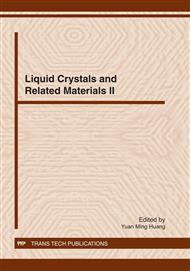p.417
p.422
p.426
p.430
p.434
p.439
p.443
p.447
p.451
Emission Spectra of Zinc Oxychloride Tellurite Glass: Effects of Eu3+/Sm3+ Co-Doping
Abstract:
Eu3+ or/and Sm3+ co-doped glasses based on TeO2-ZnO-ZnCl2-Li2O are prepared using the melt quenching technique and the effects of co-doping on the emission spectra of these glasses are examined. The Sm3+ doped glass under 403 nm excitations show emission bands around 561, 598 and 642 nm corresponding to the transitions of 4G5/2 →6H5/2, 4G5/2→6H7/2 and 4G5/2→6H9/2 respectively. Whereas, in Eu3+ doped glass under 397 nm excitation emission bands appear around 553, 586, 613, 650 and 699 nm that corresponds to the transitions of 5D1→7F2, 5D0 →7F1, 5D0 →7F2, 5D0→7F3 and 5D0→7F4. In addition, the emission spectra of the Eu3+/Sm3+ co-doped glass under 482 nm excitation consists of five bands in which three are contributed by Sm3+ at 561, 598 and 642 nm and two by Eu3+ at 613 nm and 699 nm respectively. Surprisingly, the emission bands of Eu3+ are still observed in the emission spectra of Sm3+ for the Eu3+/Sm3+ co-doped glasses despite the absence of the excitation wavelength 482 nm in the absorption and excitation domain of Eu3+. This observation is attributed to the partial resonance transfer of the absorption energy from Sm3+ to the Eu3+ ions.
Info:
Periodical:
Pages:
451-454
Citation:
Online since:
November 2011
Authors:
Price:
Сopyright:
© 2012 Trans Tech Publications Ltd. All Rights Reserved
Share:
Citation:


